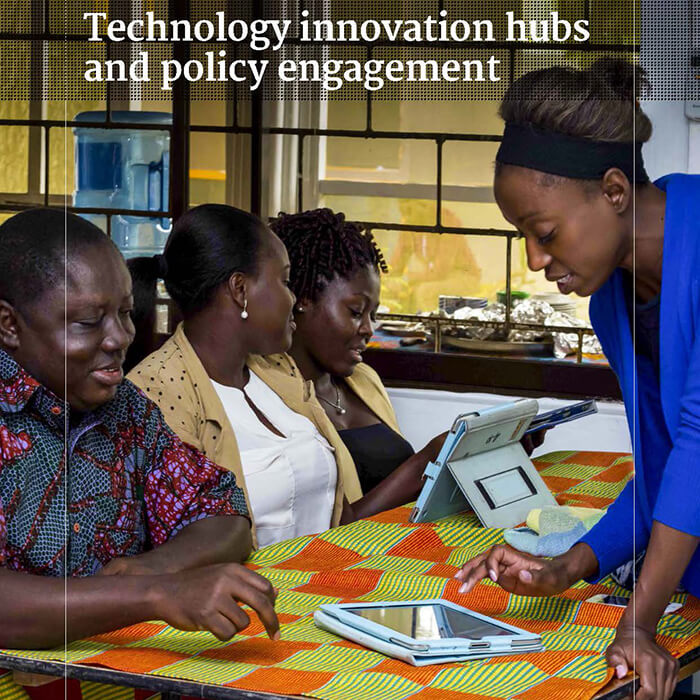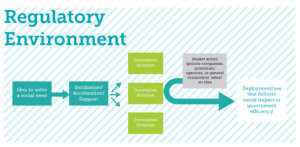To support innovative social impact, tech hubs are realizing they need to engage policymakers. But how?
When it comes to sex, there’s a wealth of information online (some more helpful than others). But it can be hard to separate fact from alternative facts—and dangerous misconceptions about sexual and reproductive health abound.
To combat this problem, Nailab, a tech innovation hub in Kenya, ran an innovators’ competition in partnership with the Kenyan National Council for Population and Development and others. The three-month campaign called on young people to talk about, learn and understand their sexuality and sexual and reproductive health by getting the facts in a safe environment. The competition produced a variety of digital platforms that do just that.
This is just one example of the social impacts tech innovation hubs can have when they co-create solutions with the government and private sector. It may be hard to imagine a government entity running a sexual health innovation competition, but the resources and information government cooperation provides can be enormous.
Tech hubs have proliferated in recent years and many have moved beyond their starting point as cheap co-working spaces into incubation centers for innovators and social entrepreneurs. Furthermore, many hubs, and the organizations that supported their initial launch, are committed to policy engagement and co-creation with the public sector because this can further support innovation and the uptake of good ideas. From workshops to strengthen local access to government information regimes, to hub engagements in customs or innovation policy overhauls, to licensing apps to government agricultural extension programs to boost their reach and efficiency, hubs are increasingly recognizing the need to engage and co-create policy solutions, and pushing for opportunities to do so. Yet, little was known concretely about what impact hubs are actually having on technology, entrepreneurship or social sector policies, or on the more fundamental need to change how governments and non-state actors work together to jointly solve problems. The Nailab example, as well as many of the other examples in our report, feature impactful projects from the hubs, confirming an insight from the early stages of this work: hubs are achieving transformational things, but much of the evidence of this impact is anecdotal.
It was this trend that led us to study the constraints and opportunities to policy engagement that tech hubs face, and to produce the Tech innovation hubs and policy engagement report. In this blog, we explore some of the key findings and insights (building on our previous “deep dive” into the tech innovation hub concept).
There is growing recognition that engaging policymakers is critical…
An increasing commitment among tech hubs to “good” governance (i.e., transparent, responsive, accountable) may reflect an increased understand that in order to successfully incubate and scale a social innovation, the larger innovation ecosystem must be supportive. The chart below helps to illustrate this point, born out of one of the interviews with Buni Hub manager Jumanne Mtambalike:
Outline of an ideal innovation ecosystem
All of the hubs cited in the report have activities in at least one, and often many, of the boxes or arrows in this chart. For example, some hubs help cultivate ideas to solve a social need and accelerate those ideas into concrete innovative solutions.
Better governance systems will be more likely to take up innovative ideas from citizens and deploy those ideas to improve the way they operate or help deliver concrete improvements to peoples’ lives—the latter two parts of the chart. Moreover, the regulatory environment surrounds and shapes hubs’ activities. This means that government policies and actions around innovation in general, or certain sectors like health and education more specifically, can either help or hinder an idea’s progress.
Thus, the opportunities and challenges of direct tech hub engagement in policy co-creation are clearly important to all stakeholders.
But negative perceptions about policymakers are still an obstacle.
The tech hubs we interviewed are overwhelmingly focused on developing solutions to pressing social challenges, usually ignoring or only indirectly recognizing policymakers as a key stakeholder, resource, or partner.
One reason for this is the consistent perception, voiced by almost every tech hub interviewee, that policy and government processes are murky, restrictive, time-sensitive and, in many cases, corrupt and overly-partisan. This perception has led to a lack of substantial, meaningful engagement.
Unsurprisingly, one of the most common asks hub managers had for policymakers was for to be more accessible, to consult with their community members, and to be open to interacting with the community in a non-partisan way.
Despite challenges, some tech hubs are finding ways to engage policymakers.
The main finding of our report was that, unfortunately, policy engagement is not the norm for most tech innovation hubs. Nevertheless, some hubs demonstrated innovative, exciting exceptions to this negative conclusion. We were therefore able to draw out some interesting lessons hubs, policymakers, and funders can consider moving forward.
-
Face-to-face contact leads to increased political buy-in and support
In Nairobi, many tech innovation hubs are clustered in a single large building, the Bishop Magua Centre. On a Friday, in March 2015, the President Uhuru Kenyatta of Kenya made an unannounced stop at the Centre. As iHub explained, “In a visit devoid of most formalities, the president took his time to listen, learn and inquire about all the technology labs and hubs.” Indeed, multiple interviewees during our research commented that physically seeing, touching and understanding what the people in these spaces were trying to accomplish and the challenges they face had a noticeable impact on the president. There has been speculation that the president’s unofficial visit directly led to a greater understanding of the sector and, subsequently, some limited improvements to importation rules for the sector in the 2015 Kenya Finance Bill presented a few months later.
-
Informal engagement with policymakers results in meaningful discourse
To support the growth and uptake of mobile innovations m:lab East Africa held weekly forums called “Wireless Wednesdays” between 2012 and 2014. These events targeted mobile innovators, entrepreneurs, industry stakeholders and thought leaders in different sectors to engage with each other in focus group discussions and explore opportunities.
The event organizers actively sought and invited government officials, and, over time, were able to bring in officials from the meteorological department, climate change experts, health sector officials and agriculture extension officers, among others. These government representatives served as important conduits and linkages to government resources and knowledge. Moreover, because they were invited to interact with stakeholders in informal settings without media coverage, there was less trepidation often brought on by formal engagement and a higher likelihood for meaningful engagement beyond carefully crafted speeches and sound bites.
From this initiative, m:lab registered success in bridging government-citizen gaps. Engagement with health sector officials who pave the way for health start-ups incubated at the m:lab who needed government access. Similarly, agricultural extension officers helped link ag-tech start-ups to farmers on the ground. Many of these linkages remain strong to this day.
-
Rallying multiple actors to advocate for a common cause is effective
Observing the organic emergence of a cluster of tech-focused companies around their neighborhood in 2012, a Lagos-based tech hub, ccHub, launched a project to assess the trend and explore what drew the entrepreneurs to the same location, with the goal of informing government policies toward innovators.
At the time, ccHub’s internet service provider, MainOne, did not have the necessary permission to lay fiber-optic cables and could only provide a slower, microwave connection insufficient for the hub’s connectivity needs. Understanding that the other tech-oriented business in their vicinity would also require fast, dedicated Internet connections, ccHub enlisted MainOne as an ally in their engagement with the Lagos State Infrastructure Maintenance and Regulatory Agency (LASIMRA). Through their research and engagement, they were able to convince LASIMRA to waive the costs and grant the licenses to lay fiber-optic cables in the neighborhood. ccHub and other entrepreneurs in Yaba now enjoy high-speed Internet connection from MainOne.
Tech innovation for social impact is a political endeavor.
This report’s main punchline is that the full potential of tech innovation hubs to contribute to a more vibrant policy ecosystem is yet to be achieved. To achieve this potential, both tech hubs and their supporters need to move beyond seeing policy engagement as partisan politics, and recognize it as a necessary link in their theories of change. The work of tech innovation hubs that seek to address social challenges is, in itself, a renegotiation of power dynamics—the solutions to pressing social challenges that are envisioned and designed in these spaces aim to renegotiate the power relationships between duty bearers and the people facing those challenges.
To that end, cultivating successful innovation ecosystems that all hubs envision requires navigating government processes, in some way or other. Although easier said than done, the sooner hubs, policymakers, and donors realize this and adapt their strategies accordingly, the more quickly they can accomplish their shared goals for lasting social change.
Research for the Technology Innovation Hubs and Policy Engagement report was led by Results for Development and funded by Making All Voices Count.
Photo: President Uhuru Kenyatta of Kenya greets Dr. Kamau Gachigi, head of Gearbox. © iHub















